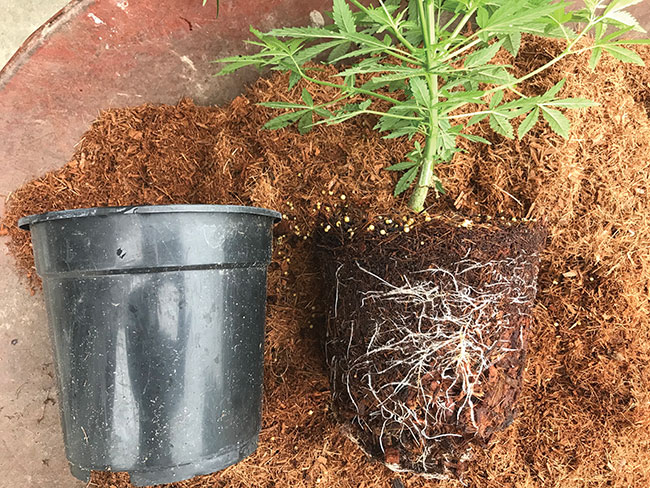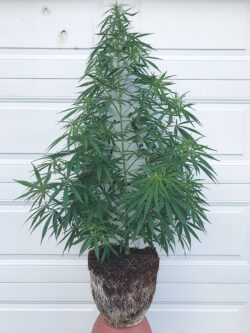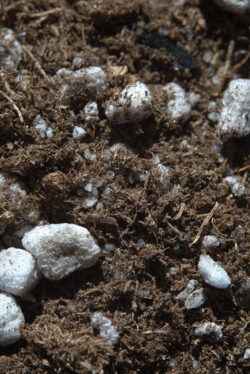
Features
Growing Media
Inputs
Putting down strong roots
Comparing growing media for cannabis production
November 24, 2023 By J Lynn Fraser
 Healthy roots of a cannabis plant grown in a coir growing medium.
Photo: Youbin Zheng
Healthy roots of a cannabis plant grown in a coir growing medium.
Photo: Youbin Zheng Is it myth, science, or Licenced Producer (LP) experience that are the variables needed to choose the best growing medium? The cannabis plant is a “complex system”1 as are the systems of regulations, economics, history, and social factors it grows within. Picking the best growing media may be an art and a craft, but this must be pursued with a complete understanding of applicable laws.
‘LPs’ in Canada
In Canada, licensing for the commercial growth and production of cannabis is the responsibility of the federal government under the Cannabis Act (justice.gc.ca).
“The main legal concern is to respect the terms of your license. The cultivation of cannabis for commercial purposes is a federally-regulated activity,” cautions Robert Frater Q.C., Chief General Counsel with the Department of Justice, Government of Canada. “There are three different classes of cultivators: micro-cultivators (those growing on a surface area of no more than 200 sq. metres); standard cultivators, who grow on areas above 200 sq m; and nursery cultivators, who grow seeds and seedlings. So legal concern number one is: are you respecting the terms of your license? There is a different class of grower who grow cannabis plants for the production of hemp. There may also be growers who want to specialize in CBD.”
As ignorance is no defence in the Canadian legal system, Frater adds: “Different licences are required for different activities.” Seeds, Frater notes, should always be obtained “from someone in Canada with a licence to produce seeds.”
Why efficient production practices matter
The commercial cannabis market in Canada is precarious. EY Canada’s “State of Canada’s Cannabis Industry Report, 2023” found that there are more than 4,000 cannabis licenses in a “highly competitive and fragmented” market.2 The report’s authors found “Government taxes and provincial markups are excessive, representing almost 50 per cent of the price of a basket of legal cannabis products.”2 The report concluded that “Cannabis companies remain unprofitable and on the verge of bankruptcy.”2 Of those companies that filed for bankruptcy in Canada in 2022, 41 per cent were cannabis companies.2 In the future it is possible that the United States may legalize cannabis thereby exposing Canadian commercial growers to competition from America’s “pharmaceutical, tobacco, and alcohol behemoths.”3
Every legal competitive advantage to maximize production and efficiency is crucial to a commercial grower’s survival.
What is the best growing medium? — It depends
LPs need growing media whose properties demonstrate a high porosity but that drain quickly while having a “moderate” water content in between irrigations.4 It should also have “fast dry downs” as this reduces root pathogens.4 Growing media should have “well-balanced physical and chemical properties” while being dependable, predictable, and weed free.4
“Some growers have twenty years of experience as well as twenty years of arguing” about the best growing media says Laila Benkrima, Ph.D., Agronomy Consultant, BC Centre for Agritech Innovation, Simon Fraser University. “It is hard for growers to switch, there is a learning curve that is not perfect.”
There are complexities to be considered. Which stage, for example, of the cannabis plants’ growth is being nurtured. Whether the plants being grown outside, in a warehouse or a greenhouse are other considerations.
“There is no best growing media,” says Dr. Youbin Zheng, a horticulture professor at the University of Guelph. After so many years of illegal growing there are “loads of myth” in the cannabis cultivation industry. Zheng believes that integrated rootzone management (IRM) approach is the key for successful cannabis production.
Coco coir
“It is the most used media. It is not 100 per cent pure,” said Benkrima. There is, she cautions, “no perfect media” but finds that “coco coir has the most advantages and the least disadvantages.” She believes that coco coir has good water retention and aeration, less root rot, drains quickly, and has anti-bacterial properties.

Healthy roots of a cannabis plant grown in a coir growing medium.
In their research into the best growing medium for cannabis, coco coir was the best growing technique and the production system Nemati et al. (2021) chose coco coir. Based on their research it demonstrated more advantages and fewer “weaknesses.”
It is “highly renewable, easy to get a hold of and deal with,” comments, Dr. Mark Lefsrud, Dept. of Bioresource Engineering, McGill University. The water holding ability of this material is good, but not ideal Lefsrud finds. It is conveniently available in cubes, bags, and slabs.
The cost of coco coir is cheap but does “depend on how many plants are produced,” notes Benkrima. She finds that coco coir and peat are comparable in price. She notes that the medium needs to be treated before it is used to remove potassium and sodium. This step adds time and energy to the process.
An advantage of coco coir, according to Zheng, is that it is a “by-product from the coconut industry. The used coir growing media can be composted with cannabis residue to be re-used in agriculture or gardening.”
There are, however, significant disadvantages associated with coco coir. It uses “tons of fresh water for washing at the processing stage,” Zheng notes. There is also a risk that it may “contain diseases if not processed and handled correctly.” This may require pesticides to deal with.
Salt (sodium chloride) is also an issue with coco coir as it has to be leached before it can be used, according to Lefsrud.
Where the coco coir is grown, forests may be cut down and agricultural land lost to supply areas for coconut palms to be grown, observes Benkrima. Some coco coir is produced in Asia then shipped to Canada. This adds to the environmental cost of the product as products are shipped from the Philippines, Indonesia, Mexico, the Caribbean, South America, India, and Sri Lanka. Some environmental impact can be ameliorated by mixing it with other media thereby using less of it.
There is variability in coco coir as they can be “different from batch to batch and make rootzone management difficult,” according to Zheng.
Rock wool
Rock wool’s advantage is that it has the best water holding and is “perfectly neutral,” according to Lefsrud. It is also good for plant growth. It is “very light, easy to handle, clean, and good to go,” says Benkrima. However, “It is expensive,” she adds.

Healthy cannabis root mat formed at the bottom of a rockwool slab.
It has no limitations to recyclability, says Lefsrud. How much rock wool is being recycled may depend on the province. Benkrima observes that in British Columbia there is limited recycling of rock wool.
In terms of production effectiveness, rock wool is “mostly homogenous with consistent qualities,” notes Zheng. This makes it “easy for rootzone management.” It is a material that is long lasting according to Lefsrud.
An issue with rock wool is that the “majority are used once, unless they are collected and reused for making bricks, etc.,” notes Zheng. The use of rock wool, when liquified, “uses a lot of energy,” Benkrima notes.
Peat moss
In their research, Nemati et al. (2021) found that peat moss had a “greater buffering capacity for water, pH and nutrients” in comparison to rock wool and phenolic foams.

Peat moss is a non-renewable resource, and it has an important function as one of the best sources of carbon sink (i.e., keeping carbon out of the atmosphere).
In comparison to other media peat had a lower level of aeration and “gas exchange rate” because of peat’s “particle size and shrinkage”4. To compensate for these weaknesses, perlite, peat chunks, and wood fiber are often added in4. The quality of peat moss quality varies, and that must be factored in when choosing a medium.
Peat moss is a non-renewable resource, and it has an important function as one of the best sources of carbon sink, i.e., keeping carbon out of the atmosphere. The challenge, as it is biological, is that it is rarely just “a single entity,” Lefsrund comments. Its use also has concerns about disease.
Benkrima notes that the disadvantages of peat moss are its higher price, and the regulations around its use. As well its use facilitates the “unsustainable exploitation of peatland contributes the greenhouse gas emissions and climate change.”
Perlite
The advantage of perlite is that it is light weight and flexible, with a consistent quality notes Zheng. The pH for perlite is good as is its electro-conductivity. It is also recyclable observes Lefsrud.
Both coco coir, which comes in bags and slabs, and perlite are “ready to go” Benkrima notes. This quality makes them both efficient to use.
Specialized considerations when growing cannabis
Cannabis waste disposal must be done by the LP. The organic waste can be composted, it can also be milled and mixed with soil, then stored for 48 hours notes Benkrima. The LP must be able to show “the full denaturation of the cannabis waste with no cannabinoids.”
When choosing and using pesticides and fertilizers
Some of the commercial fertilizers are formulated based on the experiences from the legacy market and some are not optimum nor based on scientific research, especially in regard to phosphates, Zheng said. In his research, Zheng has found that there is an overuse of phosphates. This over use can reduce cannabis yields while increasing production costs, which decreases income.
Opportunities to recycle fertilizers are not being taken advantage of according to Benkrima. Consequently, fertilizers are being disposed of down drains. This is wasteful as well as unhealthy for water systems. Fish fertilizers “Could be an alternative. So is the use of bio stimulants like seaweed extract or humic acid.”
Pesticides are on an accepted list, and any fertilizer can be used, says Lefsrund. Every batch of cannabis has to be tested for pesticide residue said Benkrima. In the future, she believes, more soilless mixtures could be used that will, “in combination with compost, and other bacterial or fungal bio stimulants,” reduce the amount of phosphates released into the environment.
Conclusion
“The important thing to remember is that the business of cannabis is highly regulated. When licenced growers want to sell their crops, they are obliged to deal with other licenced individuals,” cautions Frater. “I would certainly not recommend taking legal advice from anyone other than a qualified lawyer. There are several law firms across the country with lawyers that specialize in cannabis regulation. Cannabis is highly regulated federally, provincially, territorially, municipally and by First Nations. For the individual grower, just knowing which level of government has regulations that may affect you in some way can be a challenge.”
For LPs the production of cannabis is a complex system i.e., a layered ‘multi-web’ of licences and choices. Seeking the best legal advice and receiving formal training at one of Canada’s colleges or universities in commercial cannabis cultivation are solid first steps to success.
Resources for readers
- CBC News, (2019), “What you need to know to start a legal cannabis grow-op”, https://www.cbc.ca/news/canada/north/cbc-explains-how-to-start-a-grow-op-1.5058390
- Government of Canada, Producing and Selling Cannabis, https://www.canada.ca/en/health-canada/services/drugs-medication/cannabis/industry-licensees-applicants.html
- Government of Canada, Cannabis Licensing Application: Cultivation, processing and sale for medical purposes licence, https://www.canada.ca/en/health-canada/services/drugs-medication/cannabis/industry-licensees-applicants/licensing-summary.html
- Government of Canada, Types of Cannabis and Industrial Hemp Licences, https://www.canada.ca/en/health-canada/services/drugs-medication/cannabis/industry-licensees-applicants/applying-licence.html
- Government of Canada, Justice Laws Website, Cannabis Regulations (SOR/2018-144).
- Government of Canada, Understanding the New Access to Cannabis for Medical Purposes Regulations, https://www.canada.ca/en/health-canada/services/publications/drugs-health-products/understanding-new-access-to-cannabis-for-medical-purposes-regulations.html
- MacFarlane Q.C., B.A., Frater Q.C., R.J., & Michaelson, Q.C., C., Cannabis Law (2nd ed.) (2021). Thomas Reuters.
- Ritchie-Baum, M., Levandowski, A., Toane, C., Cramer, S. (2022). Cannabis entrepreneurship: A guide to core concepts, resources, and research strategies. Journal of Business & Finance Librarianship. DOI: 10.1080/08963568.2022.2137971 https://libres.uncg.edu/ir/uncg/f/S_Cramer_Cannabis_2022.pdf
- U.S. Embassy & Consulates in Canada, Cannabis legalization in Canada – FAQ, https://ca.usembassy.gov/cannabis-legalization-in-canada-faq/
- Zheng, Y. (Ed.) (2022). Handbook of Cannabis Production in Controlled Environments. Routledge.
Sources used
1 Naim-Feil, E., Elkins, A.C., Michelle Malmberg, M., Ram, D., Jonathan Tran, J., Spangenberg, G.C., Simone, J.R., Cogan, N.O.I. (2023). ‘The cannabis plant as a complex system: Interrelationships between cannabinoid compositions, morphological, physiological and phenological traits,’ National Library of Medicine. doi: 10.3390/plants12030493
2 E&Y (2022). https://assets.ey.com/content/dam/ey-sites/ey-com/en_ca/topics/consumer-products/ey-cannabis-coe-state-of-the-cannabis-industry-report-2023-finalpdf?aliId=eyJpIjoiOXlQbms1ZUhtbkw5MElyciIsInQiOiJEWlVUY2VyV3lBWWRqTVJScmt1MlVBPT0ifQ%253D%253D
3 Coulton, M. (2022). ‘Canada’s cannabis industry braces for increased competition as U.S. legalization looms larger.’ Financial Post. https://financialpost.com/cannabis/canadas-cannabis-industry-braces-for-increased-competition-as-u-s-legalization-looms-larger.
4 Nemati, R., Fortin, J-P., Craig, J., Donald, S. (2021). ‘Growing mediums for medical cannabis production in North America.’ Agronomy, 11(7), 1366; https://doi.org/10.3390/agronomy11071366
Print this page